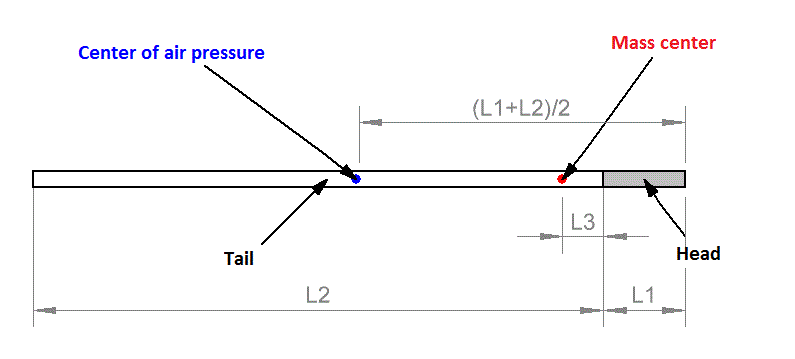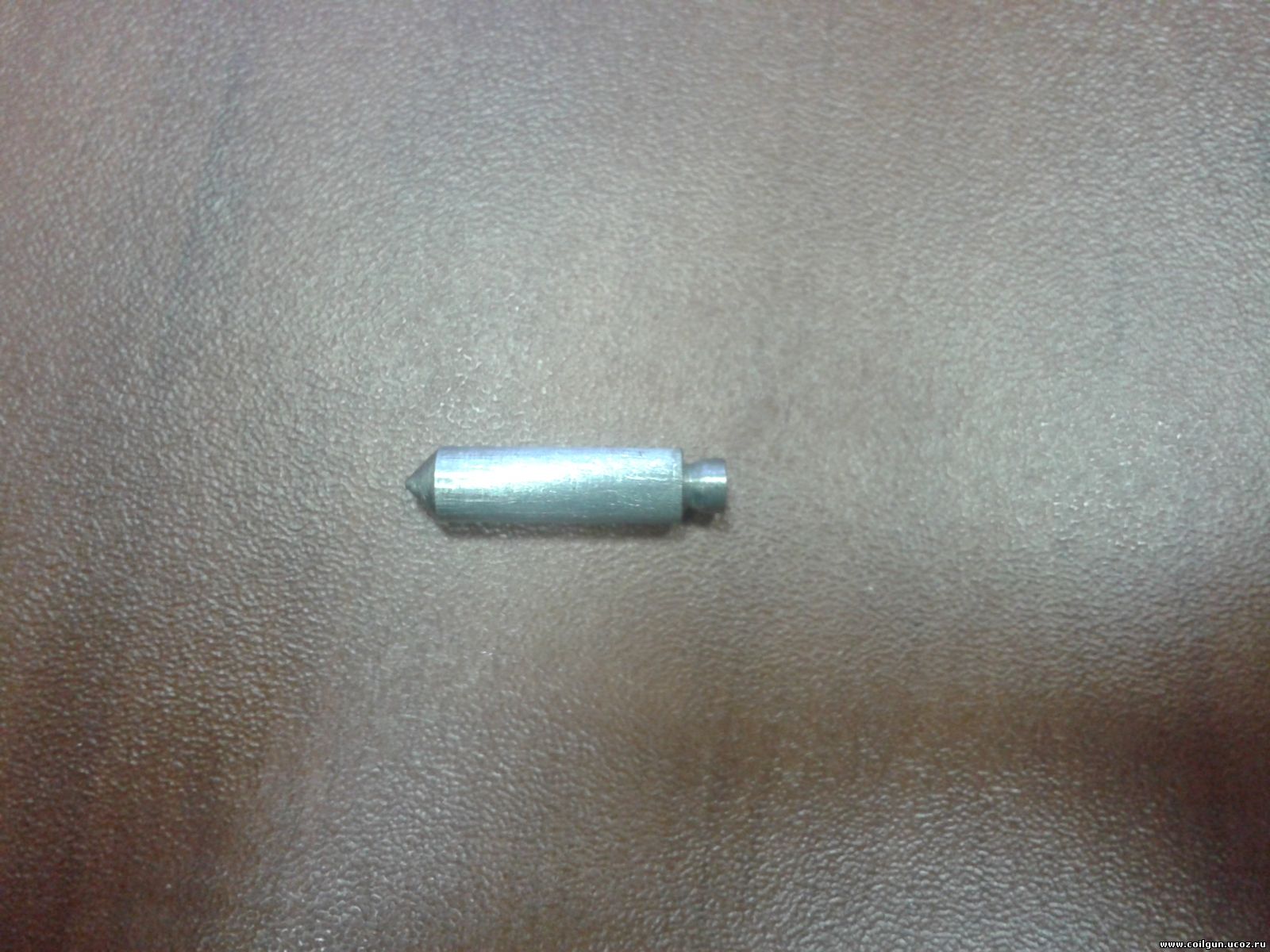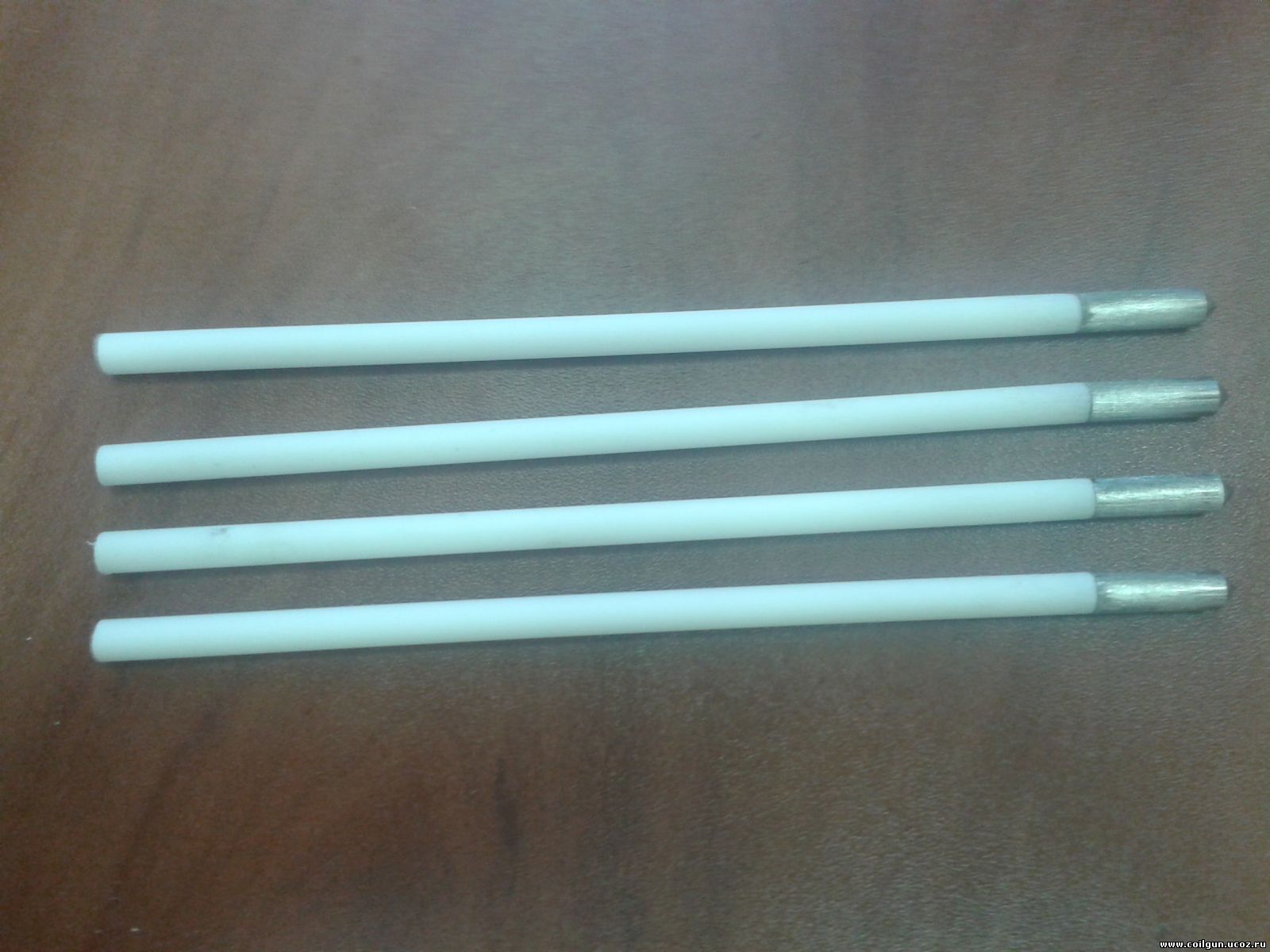| Home » Articles » Experiments » Other |
While building their coilguns, gaussers are usually trying to improve such parameters as an acceleration efficiency, initial projectile velocity, energy capacity etc. That is all important but if we want to get a construction shooting at any acceptable distance, we should think about design of the accelerated body which must satisfy some essential requirements. They are:
The projectile must meet a target with its front (striking) end, not with side or back. It is the main requirement without which all other is indifferent. Unfortunately, simple nail cuts which are so loved by coilgunners are flying directly for no more that two meters (depending on their initial velocity). Thus, such primitive projectiles must be totally rejected with only exception for a laboratory bench testing.
As the projectile is strongly stressed during a shot (especially when it hardly stops while hitting a target), it must be rather tough. For this reason I was forced to reject the arrow constructed in EM-2 project when the speed increased (it is written about in more details below).
This requirement decomposes in two:
Both these moments don’t let the standard arrows and darts to be used in a coilgun. Their heads are commonly steal but have too heavy tails (often aluminum), and feathering hampers putting them into a coilgun’s barrel. Besides, the heads have inappropriate form for the magnetic acceleration. The latter point also “kills” a possibility of using the standard steel balls which are ideal for all other points. Alas…
This criterion rejects frequently suggested constructions with gyroscopic stabilization via preliminary rotating a projectile before a shot. I think it is too complicated (however possible) to build a spinning system with demanded few thousand rps, integrated into a portative coilgun. One may also suggest a system with something like folding spring wings (as here), but it needs incredibly clever pair of hands to embed this into a coilgun’s small bullet, and the work would be more difficult than building the gaussgun itself. Missing the nails again…. The simple (and probably the only) solution is to attach a light and robust nonmagnetic shaft to a ferromagnetic core (head) with as close to cylinder form as possible, i.e. to make featherless arrow-like projectile. It is clear that the shaft’s length must be minimized (to maintain the efficiency of acceleration and to diminish the whole device’s dimensions). Thus, it is the main problem to determine a minimal length of tail assuring stable flight of the projectile. To solve it I had to search throughout the Net for the articles on archery (like this). They revealed that there is necessary condition for a stable flight: a distance from the arrow’s nose to so called “center of air pressure” must be, at least, triple to a distance from the arrow’s nose to center of mass. For the featherless projectile with equal diameters of head and tail, the center of air pressure is situated just in geometrical center of the projectile. Provided head length is L1, tail (shaft) length is L2 and coordinate of the mass center with respect to back end of the head is L3, we have following equation: (L1+L2)/2 > 3(L1+L3), which is illustrated below:
Fig. 1. Conditions for stabilization of the arrow. Earlier (working on EM-2 project) I built such arrow from standard arrowhead and cocktail plastic tube, and it proved to be good at relatively low velocities (20-30 m/s) and on mild targets (as carton or styrofoam).
Fig. 2. Arrow of EM-2 coilgun. But trying to utilize that arrow with multistage accelerator I met several challenges at once. First, thin plastic of the cocktail tube independently of its color appeared to be transparent in infrared (IR) light. For sensorless EM-2 it was not the problem, but IR detectors of EM-3 began to fail. Second, the tube doesn’t endure lateral bending – although an initial form recovers, tiny (however visible for close look) cracks appear on its surface. These cracks have sharp edges and are damaging the inside surface of transparent barrel which they are moving in, thus interfering the sensors again. Besides, any projectile being unlucky shot (for example tangentially to a target) may somersault and bump all around with any its part. At last, rapidly moving projectile penetrates deeply into any relatively dense materials (like used for standard archery targets) – I don’t even mention such materials as styrofoam frequently used by gauss-gunners. After that, the projectile must be somehow extracted from target with some force applied (archers have special devices to do that), thus thin plastic tubes as stabilizers do not suite for this. The same problems are true for other constructions of projectile with mild tails, for instance like these: Fig. 3. Some feathered projectiles of other authors (photo from http://www.foar.ru/topic.php?forum=29&topic=5&p=2 ). Thus, it is obvious that stabilizer must be rather firm although light material. After some experiments I chose these styrene modeling tubes. Despite thin walls, they are strong enough and manufactured in standard row of diameters which allows one to fit it to any caliber of his coilgun. Another advantage of polypropylene is that it is easily glued to metals (there are special compounds, but I used common epoxy). As for arrowhead, I had to contact to turner to get its necessary shape (I must say it was the only moment in constructing EM-3 when I did this, available manual tools were used in other cases). According to tradition, usual 6-mm nail was utilized as a workpiece. This is what I had as a result:
Fig. 4. Arrow head. One can see that backside of the core has mushroom-like form, a polypropylene tube of necessary length is glued to it with epoxy (its inside wall is previously treated with end of a knife or another sharp thing to have small scratches increasing adhesion). The results:
Fig. 5. Finished arrows for EM-3. Characteristics of the arrow are below:
It is clear that “parasitic” mass of the stabilizer is relatively low, and the head is still cylindrical, ensuring substantial efficiency of acceleration. The above-listed equations for ratio of lengths for head and “shaft” are also true providing good stabilization of the projectile. It is demonstrated on slow-motion videos below: I made 4 such arrows, each endured more then 40 shots by this moment. So I can surely recommend this projectile for using in coilguns.
Sincerely yours, Eugen. | |||||||||||||
| Views: 1300 | | |||||||||||||
| Total comments: 0 | |



